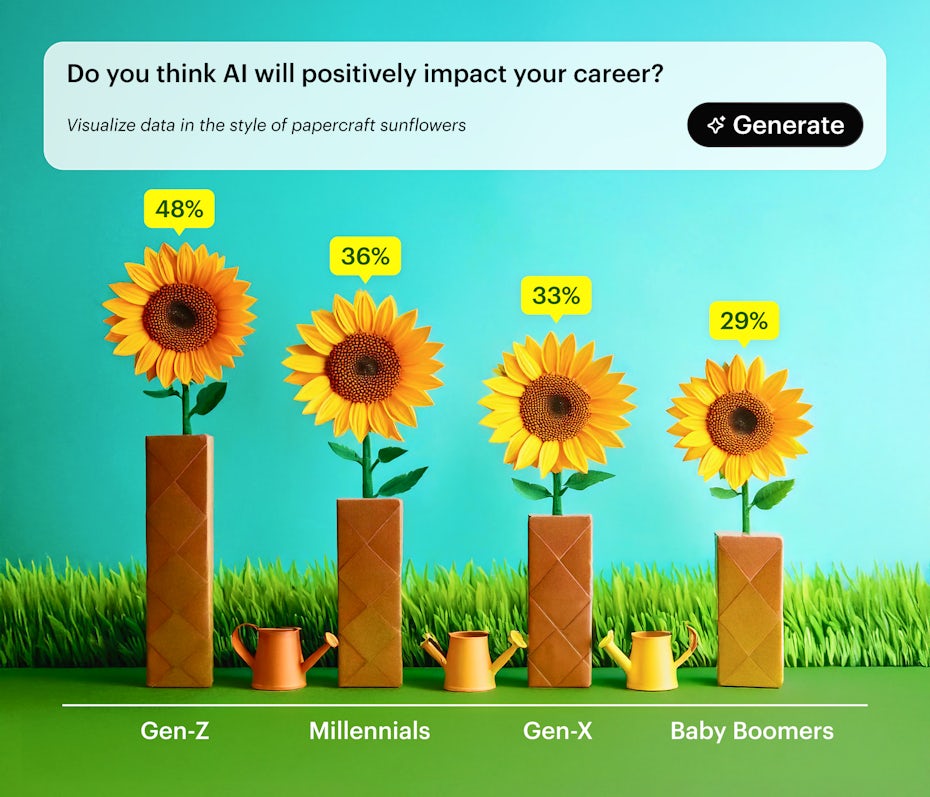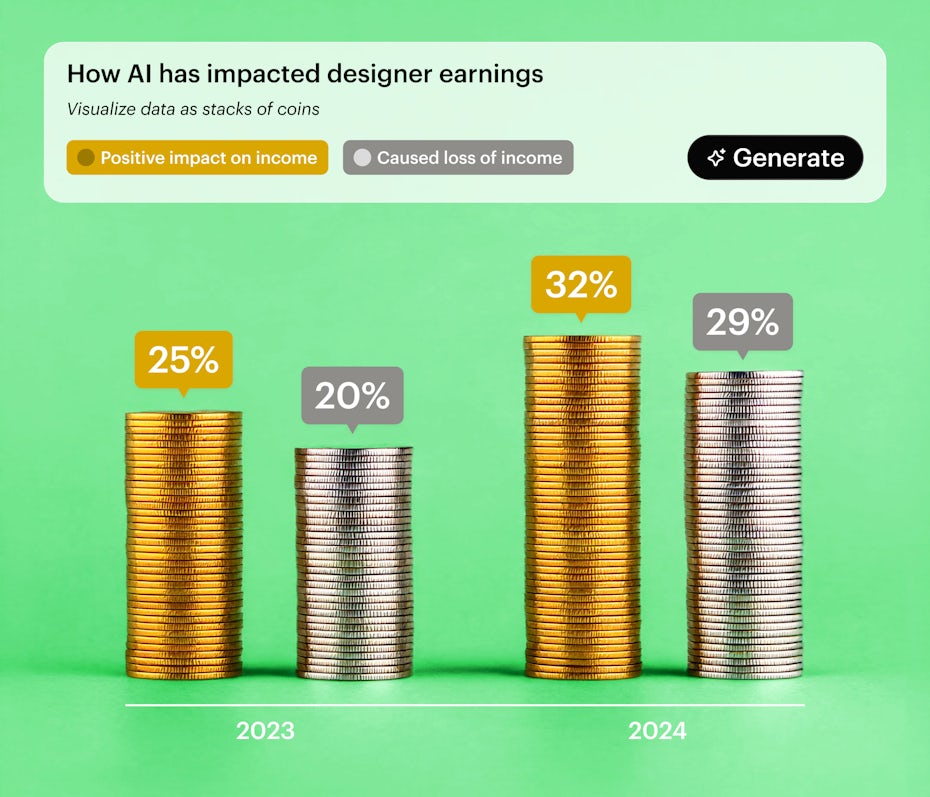[ad_1]
Irrespective of the place you’ve been, it’s inconceivable to have missed the explosive development of generative AI over the previous two years. Customers have by no means adopted a brand new know-how this shortly, and its potential to rework industries in surprising methods shouldn’t be underestimated.
On the subject of design, groundbreaking instruments like DALL-E, Midjournery and Adobe Firefly have posed eye-opening – and at occasions confronting – questions concerning the future for creatives world wide.
Is generative AI a menace to skilled designers, or will it function a software to in the end elevate human creativity? We surveyed simply over 10,000 freelance designers to know their attitudes and opinions on AI and design at the moment, and to check how these views have developed over the previous 12 months.
With enter from designers in additional than 135 nations, the information touches on matters together with how designers are utilizing generative AI of their work at the moment; how their attitudes have shifted because the know-how turns into more and more mainstream; the monetary impacts it has had, and the function they see generative AI taking part in in shaping the way forward for their careers and the design business at massive.
Though click-bait headlines typically counsel that generative AI might smash the business, solely a small variety of designers have no real interest in utilizing the know-how of their artistic work.
In truth, 52% of freelance designers are already utilizing generative AI instruments (up from 39% in 2023) and one other 24% wish to begin incorporating them of their artistic course of.
AI enhances simplicity, however not creativity.
AI adoption varies by technology, with Gen Z designers main the way in which in utilizing the know-how. Utilization decreases as age will increase, however whereas Child Boomers have the bottom present adoption charge (40%), 31% say they wish to begin utilizing generative AI instruments of their work – exhibiting there’s a want to leverage the know-how throughout age teams.

I exploit AI instruments largely for architectural visualizations. It’s useful in lots of phases of my work to improve my renders. It’s an important software as a result of it brings hand sketches again to the sport. I can sketch by hand and get primary renders in a couple of minutes. The consumer will get an virtually speedy render of the area, and I get a greater image of the consumer’s needs. The standard of those renders is normally low (for now) however adequate for me to proceed with the design.”
On the subject of how designers are levering generative AI instruments of their work, the commonest methods are:
- Broad thought technology (56%)
- Writing copy (42%)
- Automating primary duties (31%)
- Information evaluation (23%)
There isn’t a query that AI is having a big affect on the artistic industries, however there was a optimistic shift in designers’ attitudes towards AI over the previous 12 months.
Though there may be an comprehensible uncertainty and nervousness surrounding AI, the vast majority of these surveyed (56%) are enthusiastic about generative AI and the way forward for the design business.
In truth, following a interval of fast technological development over the previous 12 months, a big proportion (38%) of freelance designers really really feel extra optimistic about AI and the way forward for design now than they did a yr in the past. A smaller variety of designers (24%) really feel extra involved than they had been earlier than.
The most typical causes given for these modifications in angle are:
- Improved high quality of generative AI instruments and outputs (58%)
- Higher understanding of the capabilities and limitations of AI (58%)
- Modifications in consumer habits (32%)
Moreover, 39% of designers consider that AI will positively affect their careers in the long term, in comparison with 29% who assume it’s going to have a detrimental affect on their design profession.

The highest causes for designers anticipating a optimistic end result are that AI:
- Quickens designers’ processes (81%)
- Has the potential to enhance the artistic course of itself (69%)
- Permits designers to spend extra time on fulfilling artistic work (61%)
- Opens up new avenues of labor (51%)
- Permits designers to spend extra time on technique (43%)
If you break this down by technology, a transparent development emerges: youthful designers are inclined to have a extra optimistic view of AI’s potential affect on their careers. This optimistic outlook declines with age, indicating that Gen Z designers, who’ve adopted AI earlier, are extra optimistic concerning the future.
When requested about their whole revenue from design this yr, 58% of freelancers mentioned they anticipate incomes greater than they did final yr, with one other 23% anticipating to earn the identical. 19% mentioned that they thought they’d earn lower than they did within the earlier 12 months.
And whereas it’s not black and white, AI’s affect on freelancer earnings can be vital. 61% of designers say AI has impacted their revenue in 2024, up from simply 45% in 2023. This exhibits that AI’s impact on earnings has grown previously yr, each positively and negatively.

Extra designers really feel that AI has boosted their revenue than those that say it has prompted them to lose cash, though each teams have grown by an identical quantity.
That being mentioned, designers do anticipate this hole to widen. An enormous 80% of designers consider that AI will have an effect on their future revenue: 47% anticipate it to spice up their earnings, whereas 33% fear it’s going to result in a lack of revenue. General, this implies a optimistic outlook, but it surely’s not an easy story.
Once more, there are generational variations. The place there may be the very best adoption of generative AI, we see essentially the most optimistic affect on present revenue: 44% of Gen Z designers consider AI has led to an elevated revenue this yr, in comparison with 27% of Millennials, 25% of Gen Z and 17% of Child Boomers.
The age teams at present utilizing AI essentially the most of their work additionally anticipate it to have a greater affect on their earnings sooner or later. Nonetheless, designers of all ages anticipate that AI will improve their revenue: 57% of Gen Z, 41% of Millennials, 38% of Gen X, and 36% of Child Boomers consider that AI will result in elevated future earnings.
It’s not simply their revenue that designers anticipate AI to affect both. 63% of designers assume that generative AI will lead to model new roles current within the artistic industries.
AI doesn’t take your job, however the people who find themselves utilizing AI will take your job.
In consequence, many designers view upskilling on this space as important for preserving tempo with business modifications and future-proofing their careers. Solely 12% of designers really feel that studying the best way to use generative AI successfully is pointless, strongly suggesting a artistic future the place human creativity and generative AI are complementary components of the artistic course of.
In spite of everything, as Valeria S. factors out, “Human creativity isn’t simply concerning the finish product. It’s concerning the course of: the brainstorming, experimenting, and the accidents that result in one thing superb. AI might help with this course of, however it may’t expertise the method in the identical manner a human can. There’s a magic in human creativity that comes from our distinctive experiences, feelings, and views.”
Whereas there are clearly vital alternatives for AI and the design business at massive, alongside this fast innovation, there are nonetheless severe challenges to face.
As a miracle of science and know-how, AI is usually a double-edged sword.
The vast majority of designers (76%) consider that there are nonetheless main moral issues to be resolved in the case of generative AI, and an identical proportion (74%) assume there needs to be stricter laws round its growth and use.
Designers’ greatest issues are:
- Uncertainty round copyright and possession of AI-generated photos (69%)
- Plagiarism and work getting used to coach AI fashions with out artists’ consent (64%)
- The pace of AI growth with out moral guardrails (55%)
- Inherent bias in AI fashions (32%)
These will not be insignificant points for a gaggle of execs pushed by function, not only a paycheck, and it stays to be seen how the joy and enthusiasm for AI will align with these underlying issues long run.
We’re the academics, AI is the coed. As overwhelming because it feels, we as artistic beings have obligations and duties. The sector of that is so large and we’ve got to do what we will to show AI and ourselves the best way to use it and make it a software not a menace.
View the survey information
Get insights into the affect of AI on the design group.
This information was collected by 99designs by Vista by way of two on-line surveys distributed by way of e mail and social media in June 2024 and Could 2023. The surveys had greater than 10,000 certified freelance designer respondents from throughout 135 nations.
[ad_2]

